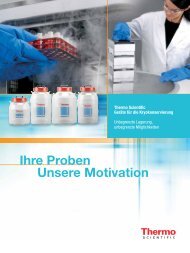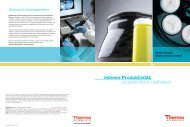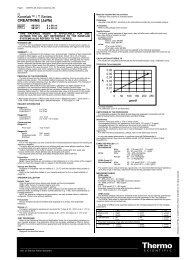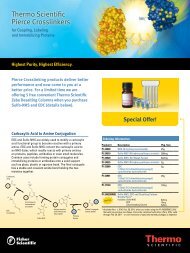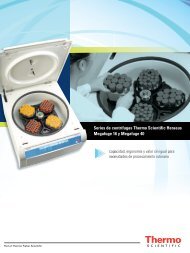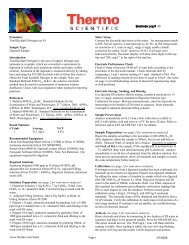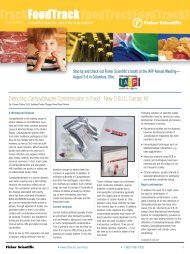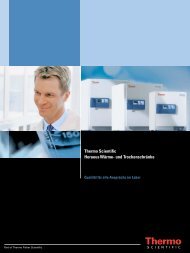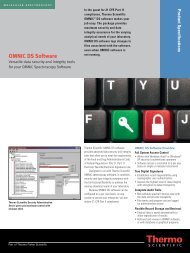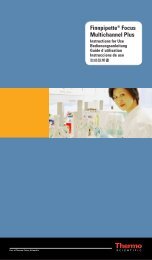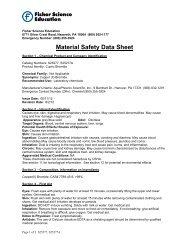DRI® Thyroxine (T4) Assay
DRI® Thyroxine (T4) Assay
DRI® Thyroxine (T4) Assay
Create successful ePaper yourself
Turn your PDF publications into a flip-book with our unique Google optimized e-Paper software.
Expected Values<br />
The range of <strong>T4</strong> concentrations of apparently healthy individuals has been determined<br />
to be 4.5 to 12 µg/dL. Since the “normal” ranges can be affected by<br />
age, gender, diet, geographic location and other factors, each laboratory should<br />
establish its own expected values for this procedure.<br />
Limitations<br />
This assay is optimized for the determination of thyroxine in serum or plasma<br />
only and not for whole blood thyroxine determination. In rare situations, patients<br />
may have autoantibody that will interfere with the assay and result in low test<br />
results.<br />
Typical Performance Characteristics<br />
The following typical performance data were generated on the Hitachi 717<br />
clinical chemistry analyzer:<br />
Precision<br />
The within-run and total run precision were evaluated with three levels of <strong>T4</strong><br />
serum controls. Following a modified CLSI precision protocol, samples were<br />
tested in replicates of 6 per run, twice a day for 5 days, with total N = 60.<br />
Level Within-run Total-run<br />
n=60 Mean (µg/dL) SD (µg/dL) CV% SD (µg/dL) CV%<br />
1<br />
2<br />
3<br />
Sensitivity<br />
Sensitivity, defined as the lowest concentration that can be differentiated from<br />
the negative serum with 95% confidence, is 0.7 µg/dL.<br />
Accuracy<br />
Specificity<br />
4.1<br />
11.0<br />
16.2<br />
0.14<br />
0.41<br />
0.62<br />
3.4<br />
3.7<br />
3.8<br />
0.28<br />
0.81<br />
1.05<br />
108 clinical samples with <strong>T4</strong> concentration range from 1.3 µg/dL to 87.1 µg/dL<br />
were assayed with DRI ® <strong>Thyroxine</strong> EIA assay and a commercially available <strong>T4</strong><br />
assay. A correlation with a regression equation of DRI (y) = 1.02 (x) - 0.63 and a<br />
correlation coefficient (r) of 0.993 was obtained.<br />
Compounds with chemical structure similar to that of thyroxine and certain concurrently<br />
used compounds were tested for possible cross reactivity in the thyroxine<br />
assay. The % cross reactivity was determined as the percent of equivalent <strong>T4</strong><br />
concentration observed when the tested concentration of the cross reactant was<br />
added to a <strong>T4</strong> negative serum.<br />
Compound Conc. Tested (µg/dL) % Cross Reactivity<br />
Triiodothyronine (T3) 10 3.2*<br />
Triiodothyroacetic Acid 10 0.5*<br />
Tetraiodothyroacetic Acid 10 25.3*<br />
3,5-Diiodothyronine 10,000 0.0<br />
3,5-Diiodotyrosine 10,000 0.0<br />
Iodotyrosine 10,000 0.0<br />
Methimazole 10,000 0.0<br />
Phenylbutazone 10,000 0.0<br />
Phenytoin 10,000 0.0<br />
Propylthiouracil 10,000 0.0<br />
Tyrosine 10,000 0.0<br />
Acetaminophen 100,000 0.0<br />
Acetylsalicylic Acid 100,000 0.0<br />
6.9<br />
7.4<br />
6.5<br />
* The tested concentrations greatly exceed the normal serum concentrations of<br />
these compounds. Therefore the cross reactivity is not clinically significant.<br />
Hemolyzed (up to 800 mg/dL hemoglobin), lipemic (up to 1000 mg/dL triglycerides<br />
or 400 mg/dL cholesterol) and icteric (up to 30 mg/dL bilirubin) samples<br />
have no clinically significant interference on the assay.<br />
Bibliography<br />
1. Ingbar SH, Woeber KA. The Thyroid Gland. In: Text Book of Endocrinology.<br />
Williams RH. ed. Philadelphia, PA; WB Saunders Company, 95 (1974).<br />
2. Robbins J. “<strong>Thyroxine</strong>-Binding Protein in Serum” In: Laborator<br />
Diagnosis of Endocrine Disease. Saunderman and Saunderman eds.,<br />
St. Louis, MO; Warren H. Green, Inc., 221 (1971).<br />
3. Larsen PR, et al. “Immunoassay of <strong>Thyroxine</strong> in Unextracted Human<br />
Serum”, J. Clin. Endocrinol. Metal., 37, 177 (1973).<br />
4. Penney M, O’Sullivan J. Total or Free <strong>Thyroxine</strong> as a Primary Test of<br />
Thyroid Function. Clin. Chem., 33, 170 (1987).<br />
5. Centers for Disease Control/National Institutes of Health manual<br />
“Biosafety in Microbiological and Biomedical Laboratories”. 1988.<br />
Manufacturer: Microgenics Corporation<br />
Customer and<br />
Technical Support<br />
North America<br />
46360 Fremont Blvd<br />
Fremont, CA 94538, USA<br />
US Toll Free: 1 800-232-3342<br />
Other countries:<br />
Please contact your local Microgenics representative.<br />
0475-3



